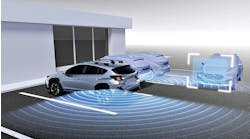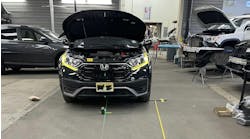Collision repair is a chaotic industry. There aren’t many businesses more complex, considering what it takes to get a vehicle out of our shops on time, repaired within the shortest possible cycle and to customer’s complete satisfaction.
Wherever I go in the world, the challenges are pretty much the same. Today, customers all demand more, and typically seem to get very agitated when things do not go according to plan. In the body repair world, this tends to be quite often. I thought this month it might be a good idea to see what can be done to increase customer satisfaction by delivering vehicles back when we promise them—there’s a challenge.
Now the obvious route may just be to err on the high side when promising a repair time. So, for a typical 15 hour repair you might allow three hours per day and promise five days, remembering of course to add in an allowance if the customer wants their car back before the weekend, as they often do. But that adds to cycle time and builds Work in Progress (WIP) enormously.
What is amazing, is that even if in the above scenario the touch time is just three hours per day, high percentages of vehicles fail to even achieve that. In fact, some studies carried out in the U.K. a couple of years ago saw average touch times of less than two hours per day. Common sense says that seems ridiculous. How can a repair estimated at just a few hours take days to process through a body shop?
Well, we all know that the problem occurs when we try to work on many jobs simultaneously. Many vehicles adding to WIP means that quite literally chaos reigns and there is a bun fight to repair the vehicle, and the winner is usually the customer who is shouting the loudest.
If your dentist kept taking in patients without proper booking schedules, then you’d be pretty upset if, in the middle of a tooth filling, he ran out of the room to work on another patient. It’s actually what we do when repairing cars, and we wonder why we sometimes upset customers.
The answer to the delivery problem is actually very simple in concept, but very difficult to carry out in practice. If you could predict when a vehicle was to enter your shop for repair, you would know the start time. If you could achieve something we call “continuous workflow,” i.e., the vehicle never stops being repaired while it is in the shop, and you know the length of the estimate, you have a far better chance of predicting the completion time. Based upon your shop or employee efficiency, you could quite closely assume a calculated “out” time and date.
But things go wrong. Parts don’t turn up, or are incorrect. Staff are ill, equipment breaks down. In our language we call these unexpected stoppages “Murphys.” It’s Murphys that contribute to your daily misery as a shop owner or manager. Because we drive our staff for ever increasing efficiencies, in a departmental system this automatically creates a stop-start to the flow. The problem is that we never know how long the stoppage is going to last until the next tech in line will be able to continue to work on the vehicle. So this stop-starting and the constant disruption caused by Murphys, along with overloading WIP, creates a very unpredictable outcome, unhappy customers and extended cycle times.
This cannot be tackled in isolation, because the subsequent result of unpredictability relies on so many different factors. To tackle the problem, the issues have to be dealt with in a holistic manner, and that is the real challenge, because it takes a brave individual to completely turn their business model upside down in the hope that it will improve things.
The real problem is that the current traditional model for collision repair is a result of years worth of isolated departmental fiddling. It’s a result of business owners taking localized problems and finding silo-based solutions that may initially seem to cure the problem, but in fact they just exaggerate a problem typically downstream.
These years of meddling have actually created a business process model that is not really fit for today’s commercial- and customer-focused world. I believe that only by understanding how a holistic approach to vehicle repair works, can you ever bring predictability into your business model. Only this approach can bring the massive reduction in WIP that is required, and remove the start-stop culture that currently exists, restoring calm to a chaotic world while significantly increasing throughput.
Jon Parker is managing director of the Byteback Group, a U.K.-based information technology and services company aimed at advancing the collision repair industry. Parker can be reached at [email protected].



